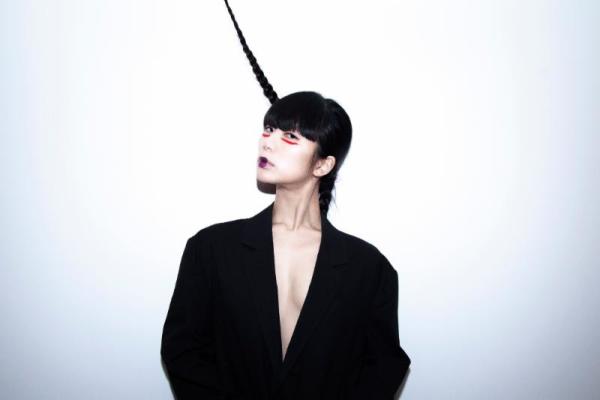Influences 05: Hatis Noit
The Erased Tapes member presents a collection of beguiling avant-garde music.

Influences 05: Hatis Noit
The Erased Tapes member presents a collection of beguiling avant-garde music.
Hatis Noit is the latest member of Robert Raths’ Erased Tapes family. The Japanese female vocal performer, an enigmatic and unknown artist, will release an “arresting” four-track record that creates “unique” song-worlds with transcendent vocal interpretations that at once deconstruct and recombine Western Classical, Japanese folk, and nature’s own ambience atmosphere. It also features Björk-collaborators Matmos, who were so impressed with Hatis Noit’s recordings that they volunteered to edit the lead track “Illogical Lullaby.”
Hailing from the distant Shiretoko, a small town in Hokkaido, the largest island in north Japan, Hatis Noit’s accomplished range is self-taught, inspired by everything she could find from Gagaku—Japanese classical music—and operatic styles, Bulgarian, and Gregorian chanting, to avant-garde and pop vocalists. It was at the age of 16, during a trek in Nepal to the Buddha’s birthplace, when she realised singing was her calling. While staying at a women’s temple in Lumbini, one morning on a walk Hatis Noit heard someone singing. On further investigation, it was a female monk singing Buddhist chants, alone. The sound moved her so intensely she was instantly aware of the visceral power of the human voice; a primal and instinctive instrument that connects us to the very essence of humanity, nature, and our universe. “The human voice is our oldest, most primal yet most powerful instrument,” she explains. “I use it to describe nature’s many sounds, a language that isn’t logical. Yet it forms a beautiful conversation that isn’t restricted to words like the human language is. I want my music to remind us of that.”
For this episode of Influences, Hatis Noit digs deep to reveal some of her favourite musical works, both old and new—ranging from Ben Frost to ancient Japanese songs that you’ve probably never heard before. It’s an emotive,
“I’ve chosen these songs because of the unique way they use the voice and musical styles that aren’t typically western harmonic. These are mostly songs that I’ve listened since I was young.”—Hatis Noit
Tracklisting
01. 宮内庁楽部 Kunaicho Shikigakubu “黄鐘調調子 Oshikicho Choshi”
02. Lisa Gerrard “Swans”
03. 芸能山城組 Geinou Yamashiro Gumi “金田 Kaneda”
04. GUERNICA “地球ゴマ Chikyu Goma”
05. 夢中夢 Mutyumu “辺土 Hendo”
06. Arvo Pärt “Spiegel im Spiegel”
07. Meredith Monk “Braid 1 And Leaping Song”
08. Ben Frost “Venter”
09. Holly Herndon “Unequal”
10. Lhasa “Anywhere On This Road”
11. ASA-CHANG & JUNRAY “Hana”
12. Yasukatsu Oshima with Geoffrey Keezer “流星 Ryusei”
01. I started this mix with Oshikicho Choshi, which is traditional Japanese court music called Gagaku. I trained in it for four years at an old temple in Kyoto.
02. Lisa Gerrard is the first female vocalist I came to love. At the age of around 17, I was so shocked and touched by the power of her voice.
03. I love Geinou Yamashiro Gumi’s culturally mixed musical style which is completely original, especially the way they use voices and rhythm. “Ra-sse-ra” is what crowds shout at traditional Japanese festivals.
04. Jun Togawa is one if my favourite Japanese female vocalists. Especially this project GUERNICA; it’s completely insane.
05. This is a track from my old band Mutyumu and it’s from before I joined them. The continuing five-four rhythm in this song recalls Buddhist chants.
06. Although I’m sure I don’t need to introduce Arvo Pärt, his music is one of my absolute favourites. This song holds a very special place in my heart as I listened to it all the way during a trip home to my birthplace in very snowy Hokkaido, when my father passed away.
07. Meredith Monk has completely changed my understanding of music, especially vocal music which is usually restricted to certain harmonies and rhythm. Her music is completely free from those, yet it’s stronger than any other voice I know.
08. Ben Frost is my favourite electronic music artist I think. When I saw his show in Tokyo, all of his sounds drew perfect layers and perspective. There were so many different sounds but it all fit into each different layer beautifully.
09. Although Holly Herndon’s music has mostly manipulated vocals, it still sounds so beautiful. I feel the special power of the human voice even if it’s through electronic sound. The same goes for 11. ASA-CHANG & JUNRAY’s “Hana,” it was the first song I heard that used edited vocals this much. It sounds quite strange but it’s still so beautiful and strong. I feel like the human voice doesn’t lose any of its original power, no matter how much it’s digitally manipulated.
10. I love the rhythm and melody of this Lhasa De Sela track, and the sound of her singing in English with a French accent. It showed me how interesting our own languages sound when sung by others.
12. Yasukatsu Oshima sings in the traditional folk music style of southern islands in Japan. His voice and melody sound very unique, warm and nostalgic. I also like that’s both folk and manages to sound new. This song always makes me happy

